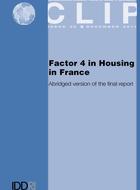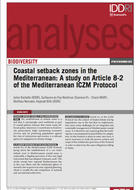Présentation [en anglais]
In today’s societies, the production base made up by the industrial fabric acts as an important link between the climate and its variations and our lifestyle. However, several decades of experience have often enabled us to minimise the impact of the weather and its fluctuations on activities, making the industrial sector out to be purely artificial and protected from climate impacts. Yet climate change leads us to challenge this assumption: if the industrial base is supposed to be impervious to the current climate, is this still the case in a context of climate change?
Article :
In an attempt to answer this question, the INVULNERABLE project was launched, led by the Institute for Sustainable Development and International Relations (IDDRI) and bringing together scientific and industrial partners (Métro-France, IPSL, CERFACS). Observing the availability of scientific resources on climate change, partly result- ing from the modeling research coordinated by the IPCC, the idea was to work with industries to identify their vulnerabilities and to use these to define indicators for climatologists. These indicators are not chosen by scientists without consulting industries, but are in fact defined by these industries to ensure they correspond to their needs as closely as possible. The challenge is therefore to bring together scientists and in- dustries and to catalyse a mutual understand- ing to ensure this discussion results in one or several indicators that are relevant to the activ- ity in question and on which climatologists can work.
Industrial activity through the prism of climate vulnerability
The impacts of climate change on activities are studied according to five focal areas, which are also five dimensions of vulnerability.
The first focal area is the impact of climate change on the availability of resources and, by extension, on suppliers, in other words on the upstream pro- duction process. For example, for a water man- agement activity, the potential reduction in the availability of water is a factor of vulnerability. The second area concerns the standards used in the design of infrastructure: are they robust in the face of climate change? Designers often use climate standards that are based on the past to de- termine the dimensions of infrastructure or pro- duction tools, and “habit” has often hidden them behind figures whose climate origin has been for- gotten. The third focal area is the impact of cli- mate change on the management of the industrial process: are there certain elements or characteristics of this process that are sensitive to the climate in general and to climate change in particular? Power plant cooling using river water is an example of a process that is sensitive to climate variables: if the temperature of the water rises beyond a certain lev- el, it can no longer be used for cooling. The fourth area is that of demand and its climate sensitivity. This is the case, for example, of demand for heating or air conditioning and its impact on electricity gen- eration or the design of district heating networks. The fifth and final area concerns the occurrence of industrial climate incidents, in other words climate disasters (violent storms, gales, floods, droughts and cold waves) that cause direct or indirect damage to the industrial base.
The development of potential vulnerability indi- cators is structured by these five focal areas for practical reasons, but they give no indication as to the outcome of discussions with industries or to the indicators that are actually chosen. In this project, it is not so much the result as the process that counts: building a dialogue with scientists, re-analysing industrial activity from a climate per- spective, and organising companies to deal with potentially global issues are all part of a learning process that will be decisive in a few years, when the development of such vulnerability indicators becomes more necessary and institutionalised. It is interesting in this respect to note the differenc- es between companies in terms of their willing- ness or capacity to integrate climate issues into their decision-making and investment processes.
Integrating climate change into industrial decision-making
The need to think now about the impacts of climate change has not yet been proved for all industrial sectors, but neither has it been estab- lished that not doing so is risk-free. As a matter of fact, few industries already take climate change into account in their investment decisions, and a number of obstacles make it difficult to even establish a dialogue. Although the reality of the phenomenon is not questioned on the whole, and even if climate change is often taken very seriously in the context of the emissions reduc- tions required of these industries, the question of the impact of this climate change on indus- trial activity is rarely, if ever, posed. One reason for this lies in the temporality of these impacts: no significant climate change is expected for a few decades, which is often beyond the normal decision-making time scale for companies. A sec- ond reason is that the climate is rarely seen as a constraint on the activity, precisely because the activity has succeeded in freeing itself from this constraint, and because it is considered to be sta- ble. A third reason is that as yet there exists no environment conducive to action for companies as economic actors: there are no regulations or prescriptive incentives (governments are often no more advanced than industries) and there is no market pressure. These two reasons make it diffi- cult to get industries interested in the issue. Some nevertheless play the game, but another problem then emerges: identifying the individuals within the company who can work on this issue of in- dicators. Although it is easier at first to involve the head office in these global, long-term issues, it is also necessary to get management support in order to legitimate and consolidate the strategy among the other bodies of the company. In a sec- ond stage, interaction with the people who know the processes and infrastructure best is essential, but means they must be identified and contacted and that they must show interest, which is no sim- ple matter. Finally, the third stage involves going back up the hierarchical ladder in order to share the experience or even to institutionalise the ap- proach. These different stages require identifica- tion and information efforts that take time and have no guarantee of success, but are nevertheless essential to the continuity of the process within the company.
Three years of experience for the INVULNER- ABLe project are not yet enough to draw conclu- sions about all of these points. However, it is clear that some industries are showing interest in climate issues, especially regarding the future occurrence of extreme events that have caused problems in the past. It also appears that the result is worth the effort: first, it is possible to identify vulnerabili- ties to climate change and to develop and inform relevant indicators; second, the need to learn how to integrate these issues and to cooperate with climatologists is quite clear. Experience in this field will be decisive in the coming years, and the INVULNERABLe project is there to contribute to this.


